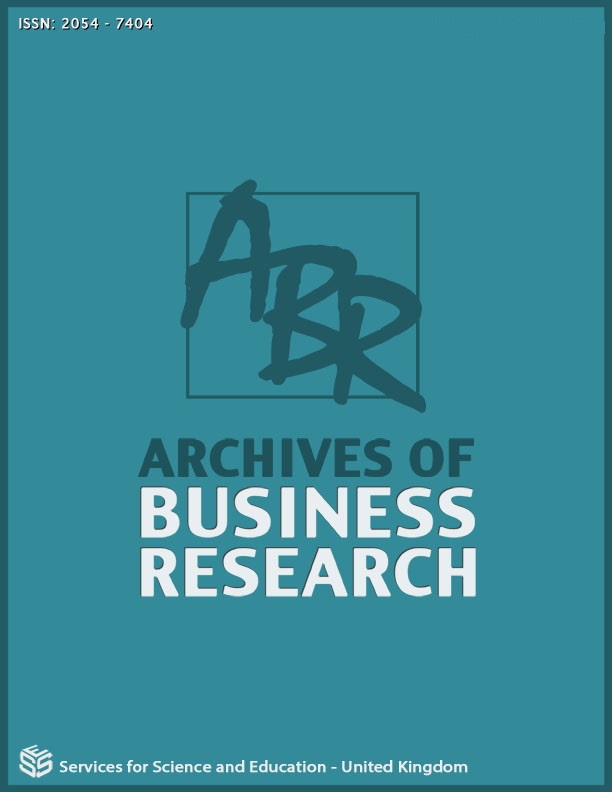Effect of Capital Structure on Growth of Nigerian Quoted Consumer Goods Firms
DOI:
https://doi.org/10.14738/abr.109.12980Keywords:
Capital structure, Earnings growth, Equity, Long term debts, Nigeria, Quoted consumer goods firmsAbstract
In a bid to responding to market demand, attaining business stability and a decent profit increase, growth has become the quest of all business owners. The study examined capital structure on growth of Nigerian quoted consumer goods firms. The population consisted of 20 Nigerian consumer goods companies as of 31st December 2018 out of which, 10 were selected as the sample size. Descriptive and inferential statistics were used for data analysis. The study revealed capital structure has no significant influence on the revenue growth of Nigerian quoted consumer goods firms (Adj.R2= 0.050510, F(6) = 1.702302, p>0.05); capital structure significantly affects total assets growth of Nigerian quoted consumer goods firms (Adj.R2= 0.073621, F(6) = 3.622586, p<0.05) and there is no significant relationship between capital structure and the earnings growth of Nigerian quoted consumer goods firms (Adj.R2= -0.025329, F(6) = 0.184805, p>0.05). The study found that capital structure has no significant influence on earnings growth and revenue growth but has a significant relationship on total assets growth of Nigerian quoted consumer goods firms. The study recommended that management should increase equity and long-term debts and reduce short-term debts so as to raise firms’ revenue and also have an understanding of the capital structure disclosure and how it affects revenue growth. Regulatory agencies should ensure assets growth disclosure, revenue, and earnings according to the laid down standards in order to enhance growth. This will boost investment in firms and in turn, raise the bar in performance and growth.
References
REFERENCE
Abdul, B., & Irwan, F. N. (2017). The Impact Of Capital Structure On Firms Performance: Evidence From Malaysian Industrial Sector –A Case Based Approach. International Journal of Accounting & Business Management, 5(2), 131-148.
Abor, J. (2005). The Effect of Capital Structure on Profitability: Empirical Analysis of Listed Firms in Ghana. Journal of Risk Finance, 6(5), 438-451.
Ahsan, A., & Kiran, S. (2017). Impact of Capital Structure on Firms Profitability: Evidence from Cement Sector of Pakistan. Research Journal of Finance and Accounting, 8(7), 29-34.
Alalade, S. A., Oguntodu, J. A., & Adelakun, V. A. (2015). Firms’ Capital Structure and Profitability Performance: A Study of Selected Food Product Companies in Nigeria. International Journal of Banking and Finance Research, 1(8), 64-83.
Berle, E., & Means, P. (1932). The Modern Corporation and Private Property. Case Study: New York.
Chadha, S., & Sharma, A. K. (2015). Capital Structure and Firm Performance: Evidence form India. SAGE Publication, 19 (4), 295 - 302.
Donaldson, G. (Division of Research, Harvard School of Business Administration). Corporate debt capacity: A study of corporate debt policy and the determination of corporate debt capacity. Boston.
Gambo, E., Ahmad, A., & Musa, A. M. (2016). Capital Structure and Firm Performance in the Nigerian Cement Industry. Business Research Archives, 4(6), 30-44.
Grace, O., Sunday, M., & Nweke, M. (2018). Capital Structure And The Performance Of Agricultural And Agro-Allied Companies In Nigeria. Journal of Economics, Management & Social Science, 4(1), 120-131.
Idode, P. E., Adeleke, T. M., Ogunlowore, A. J., & Ashogbon, O. S. (2014). Influence of capital structure on profitability: Empirical evidence from listed Nigerian banks. Journal of Business and Management, 16(11), 22-28.
Igben, R. O. (2004). Financial Accounting Made Simple. Lagos State: ROL Publishers.
Kakanda, M. M., Bello, A. B., & Abba, M. (2016). Effect of Capital Structure on Performance of Listed Consumer Goods Companies in Nigeria. Research Journal of Finance and Accounting, 7(8), 211-219.
Modligliani, F., & Miller, M. H. (1958). The Cost of Capital, Corporate Finance and the Theory of Investment. American Economic Review, 48(1), 61-97.
Mohammed, Amadeo, & Usmam, S. (2016). Corporate attributes and share value of listed pharmaceutical firms in Nigeria. Journal of Arts, Science and Commerce, 7(1), 88-98.
Offiong, A., & Edward, A. (2017). Capital Structure and the Performance of Quoted Companies in Nigeria. International Journal of Management Sciences and Business Research, 6(8), 45-52.
Olowe, R. A. (2011). Financial Management; Concepts, Financial System and Business Finance (3ed.). Lagos, Nigeria: Brierly Jones Nigeria Limited.
Owolabi, S. A., & Inyang, U. E. (2012). Determinants of Capital Structure in Nigerian Firms: A Theoretical Review. E-Canadian Journal of Accounting and Finance, 1(1), 7-15.
Saad, N. M. (2010). Corporate Governance Compliance and the Effects to capital Structure. International Journal of Economics and Financial, 2(1), 105-114.
Sunday, 1. (2015). Another look at Capital Structure and Corporate Performance in Emerging Markets: The Case of Nigeria. Asian Journal of Business Management, 7(1), 1-12.
Downloads
Published
How to Cite
Issue
Section
License
Copyright (c) 2022 Alice Anese SHIYANBOLA, Chituru Nkechinyere ALU, Ajiboso Abdullah TIMILEHIN

This work is licensed under a Creative Commons Attribution 4.0 International License.






